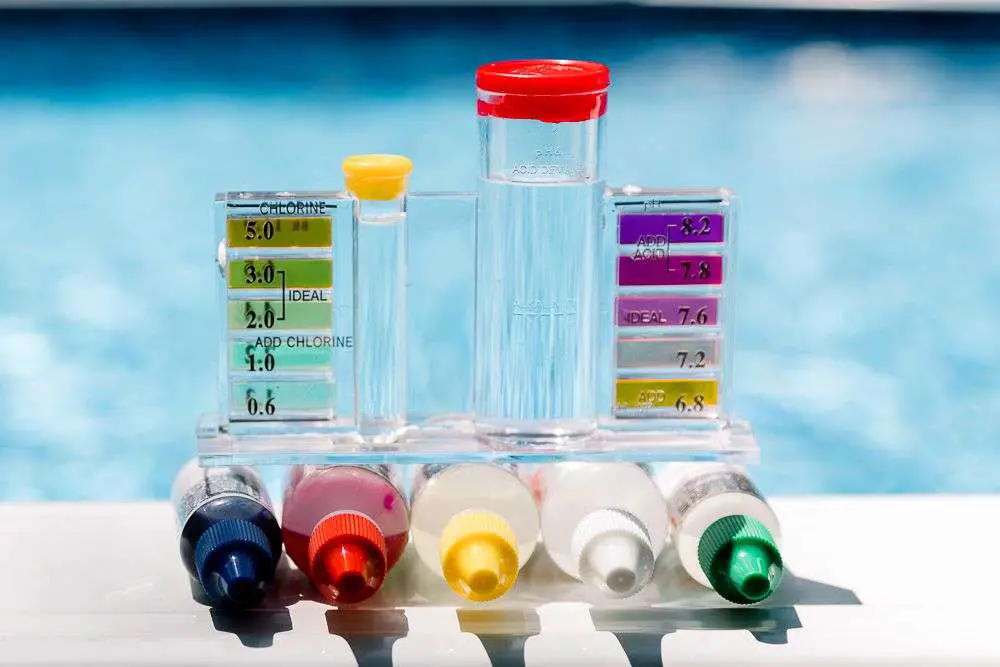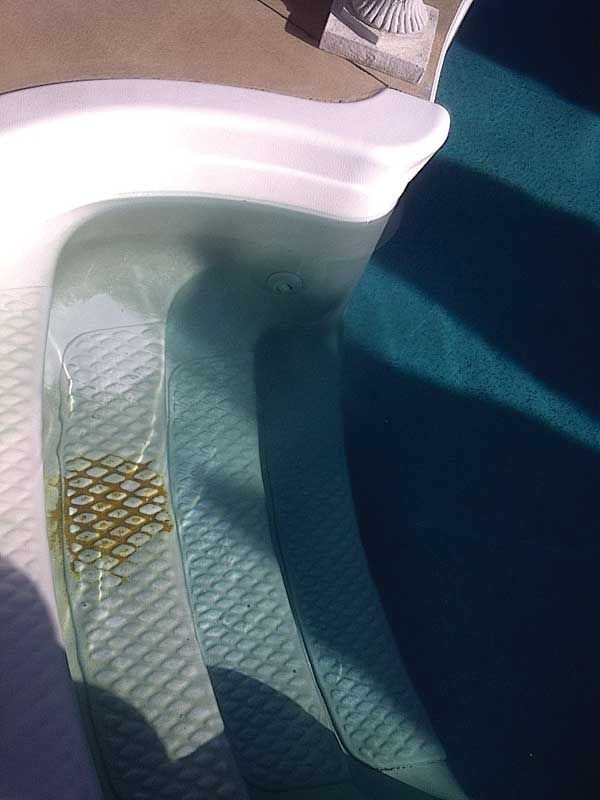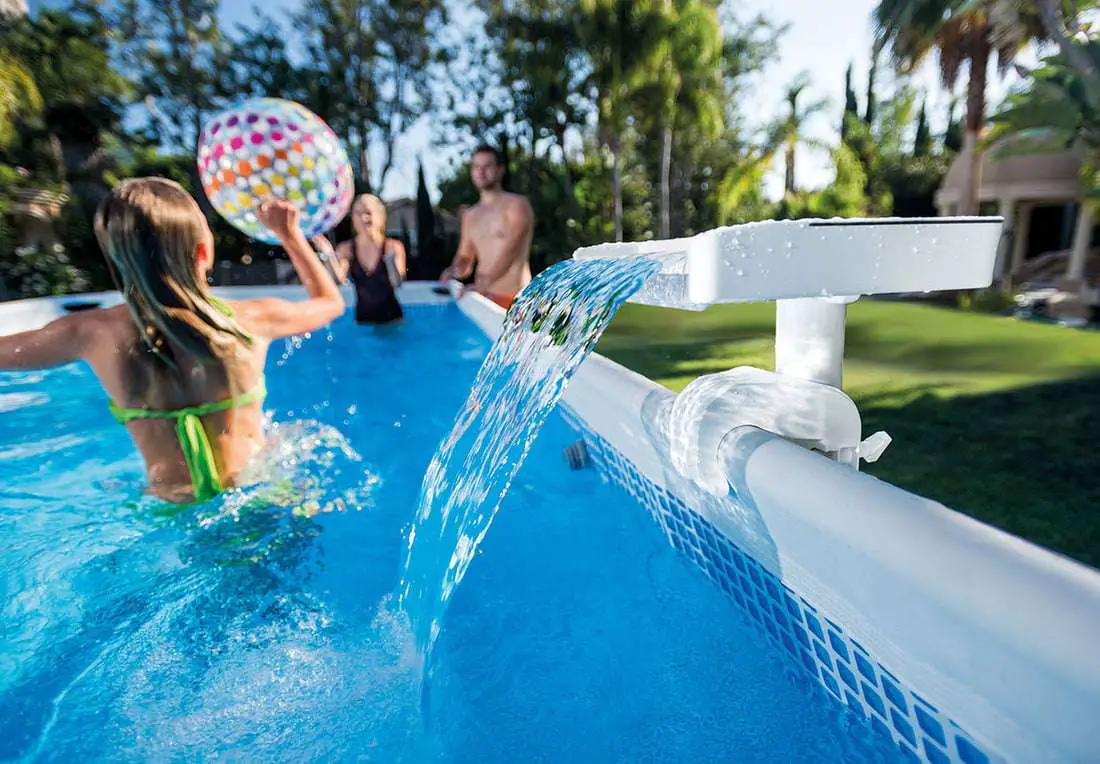Dissolved Metals Are Commonly Found In Tap Water
Source water is different everywhere you go, which is why we insist on testing tap water before filling a pool, or even servicing the pool. If you dont know what is coming out of the tap, you will be at a severe disadvantage when it comes to managing pool chemistry. Since most pool operators test only a few factorspH, total alkalinity, chlorine, and sometimes calcium hardnessotherwise predictable problems occur. To really grasp what will happen to the pool, one must know what is coming out of the tap.
If you have ever seen discolored water, or pools with metal stains, thats an obvious sign of metal content in your water. Iron, when oxidized, turns brownish or orange in color. Stains will be ugly and visible to anyone looking. Copper has more of a light green, or even turquoise look to it when it gets oxidized. Manganese has a dark color, between black and purple, depending on the severity. It is also not uncommon to see a blend of multiple metals for unique colors and stains.
How Salt Chlorinators Work
Salt Chlorinators are comprised of two components the control box and salt cell. The control box is the brains of the operation while the salt cell does all the work. The salt cell received commands from the control box to make chlorine when and for how long. Also, salt chlorinator cells can shock, or super chlorinate, your pools water.
The more technical name for salt cells is electrolytic converters. Theyre plumbed into your swimming pools return line. The key is that the salt chlorine cell MUST be installed AFTER or BEHIND the other pool equipment. The salt cell should always be installed behind the pump, filter and heater.
When a swimming pools water enters a salt chlorinators salt cell, the control box generates a very safe electrical charge, which turns dissolved pool salt into Free Chlorine. The Free Chlorine is then distributed evenly, by the pool return jets, throughout the water. Once the Free Chlorine has chlorinated the swimming pools water, the control box tells the salt cell to convert the chlorine back to salt, and the process happens over and over forever. We say forever because the salt in a saltwater swimming pool doesnt break down or evaporate. It only needs to be replaced when new water is introduced to the swimming pool due to splash out or backwashing.
Choose A Pool Water Quality Testing Kit
There are three types of testing kits that you can use.
- Test Strips: Single-use. Test strips are inexpensive, fast and easy, but their results are not as accurate as a liquid test kit.
- A liquid test kit : Multi-use. Kit includes reagents and a testing container. These kits are very accurate and affordable, are used by professionals, and will check for all the major chemicals.
- Digital Pool Testers: Multi-use. Though quick and efficient, they can be expensive to purchase or replace.
You May Like: How To Build In Ground Pool
Test The Pool’s Ph Levels
After rising the tester clean, fill the large tube to the top solid line with pool water taken from a depth of 18 inches. Add one drop of solution No. 4 and mix it by gently swirling the tube. This solution is sodium thiosulfate, a chlorine neutralizer. Add five drops of Solution 2, a phenol red indicator, and mix by gently swirling. Compare the color with the pH color standards on the plastic tester to determine the pH level of your pool water.
Note: Dont perform this test if the residual chlorine is above 3.0, as you will not get an accurate pH reading. The residual chlorine must first be adjusted to normal levels.
Lower The Free Chlorine Level To 00 Ppm

Before adding ascorbic acid, ensure that you take down the chlorine level to 0.0 ppm using a neutralizing chemical, direct sunlight, or partially draining and refilling your pool with fresh water. Lowering chlorine to 0.0 ppm is necessary, as chlorine will cause more stains, and you may need more ascorbic acid to clear the stains.
Important Note: Since clearing all-metal stains may take a couple of days with zero free chlorine, you can use ProTeam Polyquat 60 Algaecide. I recommend this because it has no copper compounds that may worsen the stains, has no ammonia that can cause extremely cloudy water that is not easy to clear and can effectively fight and prevent any algae that might thrive in your water.
Also Check: Natural Gas Pool Heater Sizing
Hardness Total & Calcium
Total hardness refers to the level of dissolved calcium and magnesium in the water. The most common form of hardness in pools is Calcium Hardness. It can come from fill-water or forms of chlorine, such as calcium hypochlorite, or the intentional addition of calcium chloride. Owners of plaster pools must avoid low hardness levels, especially when opening a new pool, since water can dissolve plaster from the pool walls if hardness is too low . In other types of pool surfaces it is vital to keep hardness levels within ideal ranges to prevent etching or dissolving hardware components, such as heaters and plumbing.
If the hardness level is too high, the water can become cloudy, then scale may begin to form on pool surfaces and equipment. Scale will appear as small white or tan deposits at the water level on walls, ladders, and numerous other places that the owner may not see. If left uncorrected, scale can clog pipes, filters, and damage heaters.
If hardness is too high, the best option is to dilute it with fresh water that is low in hardness. If the hardness level is too low, add calcium chloride to the pool as recommended in the treatment tables , but carefully read the precautions for use! Mixing calcium chloride and water in a bucket can generate a very warm solution .
How To Remove Metals From Water
With certain types of filter media, metals can actually be filtered out. Such products do exist, but they can be costly. One such example is reverse osmosis, which takes just about everything out of the watermetals included. There are specific metal trapping filters that can be attached to hoses and plumbing that target heavy metals specifically as well. Some pool filters can also trap metals if they have a small enough filter media. Even so, with the help of certain sequestering agents, filters can capture metals to be backwashed or removed from the water.
If your metals are very high, removing them is a good idea. The less heavy metals you have in your water, the easier to manage.
Don’t Miss: Iron Out For Pools
How To Test Your Pool Water For Salt
To keep your chlorinator running well, and your chlorine at optimal levels, you want to shoot for a salt level of approximately 3,200 ppm. Once again, specialty test strips are the fast and easy method to determine pool water salt levels.
Using them is a simple matter of collecting a water sample in a test tube, dunking a dry test strip into the tube, removing it, and waiting about 20 seconds for the results.
In 1 Drinking Water Test Kit Strips
Med Lab Diagnosticâs 16 in 1 drinking water test kit can measure 16 pool water parameters including Copper, Iron, Mercury, Lead, and Aluminum. It contains 200 test strips in two separate sealed pouches. Each of the pouches has 100 strips so the strips will have a longer shelf life. The shelf life of the strips is 2 years when they are sealed. Once they are opened, the strips are generally good for approximately 90 days. These water testing strips provide accurate results very quickly and easily for testing your pool water. They are made from biodegradable material so Safe for the environment. These strips come with a full color instruction guide which has information about each of the 16 parameter tested. Although the Med Lab Diagnostics is a USA company its product is manufactured in China.
Also Check: Vacuums For Intex Pools
Test For Total Alkalinity
After rinsing the tester clean, fill the large tube to the lower dash line. Add one drop of No. 4 solution and swirl. Next, add one drop of solution No. 5B, a total alkalinity indicator, and swirl. Add No. 3 solution, drop by drop until the color changes to clear, light yellow, or light green.
Finally, multiply the number of drops of solution No. 3 you used by 10 to determine the total alkalinity.
Note: Don’t perform this test if the residual chlorine is above 3.0. Chlorine must be in normal ranges before testing for TA .
Chemistry Basics: Balancing Swimming Pool And Spa Water
In this section, well dive into the detail of what healthy balanced water means. Well look at not just the beauty of clean and clear swimming pool water, but the chemistry makeup of the water. Well also explore what truly balanced water means, how to achieve balance, and how to maintain it. And finally well give you tricks and tips on how to get your pools water back in balance.
Proper swimming pool water filtration and sanitization are essential for swimmer comfort and safety. However, out of balance swimming pool water can cause more issues than red eyes and dry skin it can damage your equipment and surfaces if scale or corrosion occurs. Properly balanced swimming pool water will prevent metal corrosion as well as pool surface scaling.
Top Five factors of balanced water:
Recommended Reading: Tankless Pool Heater
Biguanide & Biguanide Shock
Polyhexamethylene biguanide is a bactericide used as a non-chlorine water sanitizer. It uses quaternary ammonium compounds and hydrogen peroxide, as an oxidizer, called Biguanide Shock. Chlorine, bromine, metals or monopersulfate should never be used with this system.
The recommended concentration of Biguanide is 30-50 ppm. Regular maintenance doses of the algicide and oxidizer are recommended. Check the manufacturers label for dosages.
Testing For Copper: Getting Rid Of The Green

If your pool water is cloudy, or you have greenish or black stains on your liner, copper is a prime suspect. Copper buildup usually happens for one of two main reasons.
First, the tap water you use to fill your pool may contain trace amounts of copper. As water evaporates from your pool, it leaves the copper behind. The less water in the pool, the higher the copper levels.
To counter evaporation, youll add more water, which means you add more copper, and then more water evaporates, and that leavesyou guessed itmore copper in your pool.
Second, low pH levels can cause copper elements in your pool filter or plumbing to corrode. The corrosion will then make its way into your pool water. The longer the corrosion is left unaddressed, the more copper buildup youll have in your water.
Greenish stains on the pool walls and floors may be an indication of too much copper in your pool water.
Read Also: Repair Above Ground Pool Wall
How To Use Test Strips
In addition to being super quick and easy to use, test strips can also sometimes be more accurate than liquid test kits because human error can make it difficult to match up the colors using the chemical drops.
Test strips are also usually less expensive than liquid kits, but youll go through them more quickly, so it just about balances out.
To use them:
The type of strips youll use most often are general ones that check for the primary components of ideal pool water: pH, alkalinity, and chlorine. But youll also find specialty strips that test for things like copper, iron and salt.
Get Chlorine Back To Normal Levels
Raise your free chlorine level to 1.0 or 2.0 and leave it there. You need to use liquid chlorine bleach for this purpose.
Be cautious while adding chlorine, and watch for any staining in the process. Ensure that you keep your chlorine at the minimum level possible, depending on the available cyanuric acid level.
You can use a chlorine/cyanuric acid chart or pool calculator to find the accurate amount of free chlorine you need.
After getting the chlorine to the recommended level between 1 and 2 ppm, avoid shocking your pool for about two weeks to allow the ascorbic acid to be completely used up. After about two weeks, you will notice chlorine being used up as usual. You can then begin to shock your pool carefully to avoid adding excess chlorine.
Important Note: High pH levels and chlorine will definitely precipitate any metal compound in your water if not treated or removed out of your water.
Also Check: How Many Btus Do I Need To Heat My Patio
Testing The Pool Wateris It Metal Staining Or Algae
Before taking any action to undergo treatment for metal stains, you need to be certain of its metal staining. Green or black stains might indicate metal stains, but they may also occur due to green or black algae. Do the vitamin C test by using ascorbic acid to determine whether it’s metal staining or not:
Sign Up For The Poolstyle E
Receive the latest design trends, hot products, special offers, and more!
Testing your pool is a regular part of pool ownership. Its essential to maintaining water that is crystal clear and algae free. Its also important to maintain a good balance of chemicals in your pool because improper water chemistry can cause damage to your pool and equipment. Beyond that, imbalanced water can cause eye irritation and hair discoloration. Yikes. To get an accurate reading, you’ll need a test kit, a test strip, or a water sample for a pool professional.
Also Check: Concrete Pool Deck Repair Cost
How To Remove Metal Stains In A Pool
Removing existing stains is a different issue, but similar steps to remedy.
Pool stain removal can take minutes or it can take weeks. There are too many variables that impact the process to discuss here. Moving forward from stain removal, follow the steps above for prevention, which should help eliminate the problem long term.
In full disclosure, stain removal is not Orenda’s specialty. We are far better at preventing them than removing them. If you already have stubborn stains, consider more specialized products and techniques.
How Do I Test Pool Water
There are several types of testing supplies available on the market varying in price and accuracy. Since I work for a company that sells pool supplies, it was fairly easy for me to get customer input via our amazing review program, and I was able to narrow down the bestselling water testing supplies to make it easier for you to make the selection to your liking.
Read Also: Deepest Intex Pool
How To Clear Green Pool Water
- |December 5, 2020
Swimming pools can be tailored to a specific aesthetic , from the shape and size of the pool, to the landscaping around it, right down to the color of the water.
But when we talk about fixing green pool water, were referring to dirty pools where the water suddenly changed, making it toxic to swim in.
The first thing you need to figure out is
Skip to:
Heavy Metals: Oxidation And Metal Staining

It’s your one-way ticket to midnight. Call it heavy metal.Oh wait, we’re talking about dissolved metals in water. Just uhh…disregard that Sammy Hagar reference. Sorry.
In this article we will be discussing metals in swimming pools. How they interact with other things in water like chlorine, and also how to prevent issues like stains. We will cover oxidation, sequestration and chelation, and attempt to simplify these terms.
Also Check: Intex Pool Shortage 2021
Pool Store Tested For Metals With Test Strips
Ascorbic acid works best with iron stains. AA is not a good treatment for copper stains, which may appear somewhat similar to iron stains. When you use AA with copper stains, the stains may lift off, or they may turn black. When black they are often even more difficult to remove then they are when tan/brown. Turning black is a result of a change in the oxidation level of the copper. Several oxidation levels are possible, resulting in several possible colors for copper stains. The best treatment for copper stains is an acid wash.
